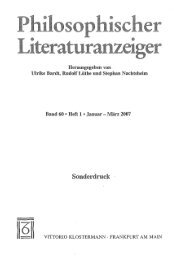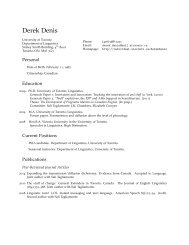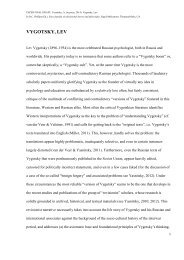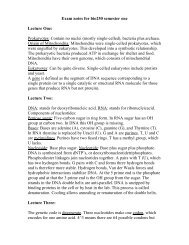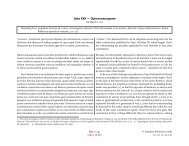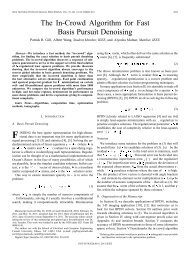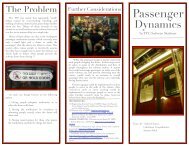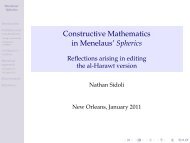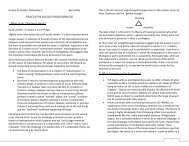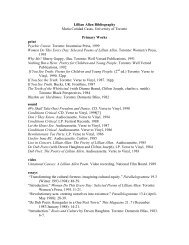Synapsid Lecture 5
Synapsid Lecture 5
Synapsid Lecture 5
You also want an ePaper? Increase the reach of your titles
YUMPU automatically turns print PDFs into web optimized ePapers that Google loves.
<strong>Synapsid</strong>s<br />
• Main group we’re focusing on –mammals.<br />
• Mammalia –monophyletic group.<br />
• “Pelycosaurs” –non mammalian synapsids<br />
• Three groups:<br />
o Pelycosaurs (refer more to a grade than a clade) –primitive synapsids<br />
o Therapsids –advanced synapsids<br />
§ Mammals<br />
• Monotremata<br />
• Theria:<br />
o Eutheria (Placentals)<br />
o Metatheria (marsupials)<br />
Mammals<br />
• Diagnose them by soft-tissue characters:<br />
o Mammary glands –important in reproductive mode (where mammals<br />
get their name). Functional in the females (with exceptions).<br />
o Hair<br />
o Muscular diaphragm –partition that separates the thoracic from the<br />
abdominal pelvic cavity<br />
§ Muscle that is helpful in ventilating the lungs.<br />
o Problematic if we go into fossil records, as they do not fossilize.<br />
o What we tend to do is to look for other features of the skeleton that<br />
help us define what mammals are and they survey these characters in<br />
the fossil record.<br />
§ Presence of 1 bone in each half of the lower jaw –the dentary.<br />
• Upper joint: Squamosal, lower jaw: dentary<br />
• Differs from reptiles:<br />
o Upper joint: Quadrate, lower joint: articular.<br />
(The quadrate-articular articulation)<br />
§ Middle ear ossicles (little bones)<br />
• Reptiles: 1 bone –the stapes (collamila in mammals).<br />
• Mammals: 3 bones –the malleus, incus and<br />
stapes/collamia (outside to inside, lateral-medial).<br />
o Stapes is the same as the reptile; others are<br />
derived from the other bones used to make up<br />
the jaw joint in reptile. Seen as a transitional<br />
sequence in embryos.<br />
o The angular bone in the reptile becomes a part of<br />
the bones forming the mammalian outer ear that<br />
holds the eardrum –acultonpact.<br />
§ These conditions are for modern mammalians, if we go back in<br />
time there are several synapsids that approach the mammalian<br />
form (in term of the skeletal organization), some became<br />
extinct and some survived. We also see transitional forms in<br />
which the upper jaw was formed by part of the squamosal and<br />
part of the quadrate, while similarly the lower jaw was formed
Two main types:<br />
by the dentary and articular bones. This is similarly observed<br />
in embryos.<br />
§ These early mammals –or synapsids do go back a long way.<br />
The synapsids are one of the main groups of the amniotes –and<br />
are quite old. Nearly wiped out during dinosaur ear (Triassic,<br />
Jurassic and Cretaceous) and regained diversity in the Tertiary.<br />
§ Pelycosaurs –dimetrodon (carnivores), edaphosaurus<br />
(herbivores). Early synapsids. Limbs spread out to the side,<br />
sprawling posture.<br />
§ Therapsids –moschops, titanophoneus. Change limbs are<br />
swung under the body, like a cat and moving on a parasagittal<br />
plane. Increased speed (less lower body friction) opened up<br />
different niches and is able to chase bigger and faster prey.<br />
• Monotremata –platypus, echidna<br />
o Shelled egg, but have hair and mammary glands.<br />
o They still have a cloaca (literally “one opening”, for digestive and<br />
reproductive tract).<br />
o Lateral braincase walls is formed by a bone called periodic<br />
• Theria:<br />
o Lateral braincase walls formed by a bone called alisphenoid (distinct<br />
from monotremes)<br />
o Metatheria: pouched mammals or the marsupials, and several<br />
extinct forms (fossil forms). Not all marsupials are pouched animals,<br />
i.e. opossum (carnivorous) and kangaroos (deprotodons –enlarged<br />
front teeth [incisors]). The young are born at a very immature, and<br />
must make their way up to the pouch clamp on with their teeth and<br />
finish development in the pouch.<br />
o Eutheria: placental (placenta is also present in marsupials). Different<br />
kind of a placental –their placental allows the young to stay in the<br />
utero for a longer period of time, thus the young emerges at a later<br />
time in development.<br />
§ Main groups:<br />
• Chiroptera: flying mammal, bats –one of the most<br />
diversified and specious<br />
• Rodentia: rodents, mice, rats –even more diversified.<br />
Enlargement of the incisors, can set jaw in 2 position<br />
grinding and gnarling.<br />
• Carnivora:<br />
o Cat-like forms<br />
o Dog-like forms<br />
• Ungulate: walking on their nail/hoofs (cows, giraffe<br />
etc.)<br />
o Artiodactyla: Grass, foliage. Cows, giraffes and<br />
hippos. Parasonic symmetry, lines of symmetry<br />
in fingers 3 and 4. Raise foot and walk on tip-toes.
§ Cetacea (whales and propoises) closely<br />
related to hippos.<br />
o Perissodactyla: Horse, Zebras and Rhinos.<br />
Bizonic only the middle finger, horses walking on<br />
their middle finger.<br />
• Proboscidea: mammoths, elephants<br />
• Sirenia: sea cows (gentle underwater cows).<br />
• Zenapora: tree sloths, south American anteaters,<br />
armadillos. Great rich fossil record.<br />
• Primates: humans, and other great apes (gorillas,<br />
orangutans).<br />
o No particular advantage in reproductive strategy (despite the greater<br />
quantity of placental vs. marsupials), but it seems that marsupials do<br />
particularly well in response to stressful changes in the environment.<br />
Whereas in stable environments, placental do well but when things<br />
change so do their reproductive fortunes. In one you can ditch<br />
(marsupials) the offspring when in stress, they may have multiple<br />
offspring at the same time.



